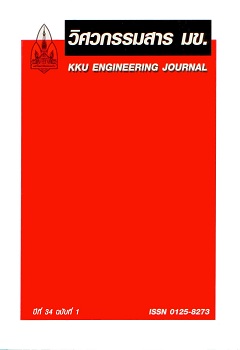Comparison of Signal Processing Techniques for Fault Detection in Helical Spur Gears
Main Article Content
Abstract
The paper presents the use of signal processing techniques for fault detection in helical spurgears. The test rig of helical spur gear mesh is set up. Three levels of gear teeth damage are simulatedand vibration response of each damage level is measured. Three signal processing techniques,including spectral, cepstrum and wavelet analyses are used to detect gear fault from vibration signalsanalysis. The analysis results obtained from the various techniques are compared. The advantages anddisadvantages of the techniques are discussed. The experimental result reveals that the amplitude,gamnitude and magnitude from the analysis are decreased at damage level more than 50%thickness. The result suggests that the spectrum technique is suitable to use for stationarysignal only. However this technique is still used widely because it is capable with presenttools. The cepstrum technique can be used to extend the detail of spectrum technique. It isalso suitable for high speed and high load situations. Wavelet analysis in considering the besttechnique as it can not only detect the fault of gear teeth accurately but also indicate the damageposition.
Article Details
How to Cite
Hamcumpai, S., Bureerat, S., & Eua-Anant, N. (2012). Comparison of Signal Processing Techniques for Fault Detection in Helical Spur Gears. Engineering and Applied Science Research, 34(1), 59–72. retrieved from https://ph01.tci-thaijo.org/index.php/easr/article/view/1803
Issue
Section
ORIGINAL RESEARCH
This work is licensed under a Creative Commons Attribution-NonCommercial-NoDerivatives 4.0 International License.



